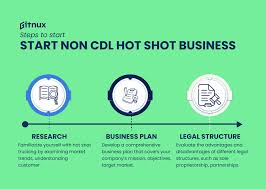Understanding the Hot Shot Business
Defining Hot Shot Trucking
Hot shot trucking, also known as expedited freight, involves transporting smaller, time-sensitive loads quickly and efficiently. Unlike traditional freight, hot shot loads are usually carried by smaller trucks and trailers, often operating as owner-operators.
Pros and Cons of Hot Shot Trucking
Running a hot shot business comes with its share of advantages, such as flexibility, faster payment cycles, and potential for high earning per mile. However, challenges like intense competition and irregular work hours need to be considered.
Is Hot Shot Trucking Right for You?
Before diving in, evaluate if hot shot trucking aligns with your goals and lifestyle. Assess factors like your willingness to handle high-pressure situations, long hours on the road, and the demands of managing a business.
Planning Your Hot Shot Business
Research and Market Analysis
Conduct thorough market research to understand the demand for hot shot services in your area. Identify potential customers, routes, and the types of loads that are frequently transported.
Choosing Your Niche and Services
Consider specializing in a specific niche or industry, such as delivering construction materials or agricultural products. This can help you target a specific market and tailor your services accordingly.
Creating a Business Plan
A well-structured business plan outlines your goals, target market, competitive analysis, financial projections, and marketing strategies. This document will serve as your roadmap for success and can also be useful when seeking funding.
Legal and Regulatory Requirements
Business Registration and Licensing
Register your business and obtain the necessary licenses and permits. Choose a suitable business structure, like a sole proprietorship or limited liability company (LLC), and ensure compliance with local regulations.
DOT and Motor Carrier Authority
If you’re planning to operate interstate, you’ll need to obtain a USDOT number and motor carrier authority from the Federal Motor Carrier Safety Administration (FMCSA). This step ensures you meet safety and operational standards.
Insurance Coverage
Securing proper insurance coverage, including liability and cargo insurance, is crucial for protecting your business and assets in case of accidents, damages, or losses.
Fleet and Equipment
Selecting the Right Truck and Trailer
Choose a truck and trailer combination that suits your business needs. Factors like payload capacity, fuel efficiency, and versatility are important considerations.
Maintenance and Upkeep
Regular maintenance is essential to keep your equipment in optimal condition. Develop a maintenance schedule to prevent breakdowns and ensure the safety of your drivers and cargo.
Ensuring Safety and Compliance
Follow safety protocols and regulations to ensure the well-being of your drivers and compliance with industry standards. Safety should always be a top priority.
Building Client Relationships
Identifying Target Customers
Determine your ideal customers based on the industries you serve and the types of loads you transport. Building relationships with shippers and brokers can lead to repeat business.
Effective Communication and Networking
Clear communication with clients and partners is key to successful operations. Attend industry events, join online forums, and network with others in the transportation field.
Providing Exceptional Customer Service
Going the extra mile in customer service can set you apart from competitors. Timely deliveries, transparent communication, and problem-solving can lead to positive reviews and referrals.
Stay tuned for the second part of this article, where we’ll cover more crucial steps to help you launch your hot shot business successfully.
Access Now: https://bit.ly/J_Umma


